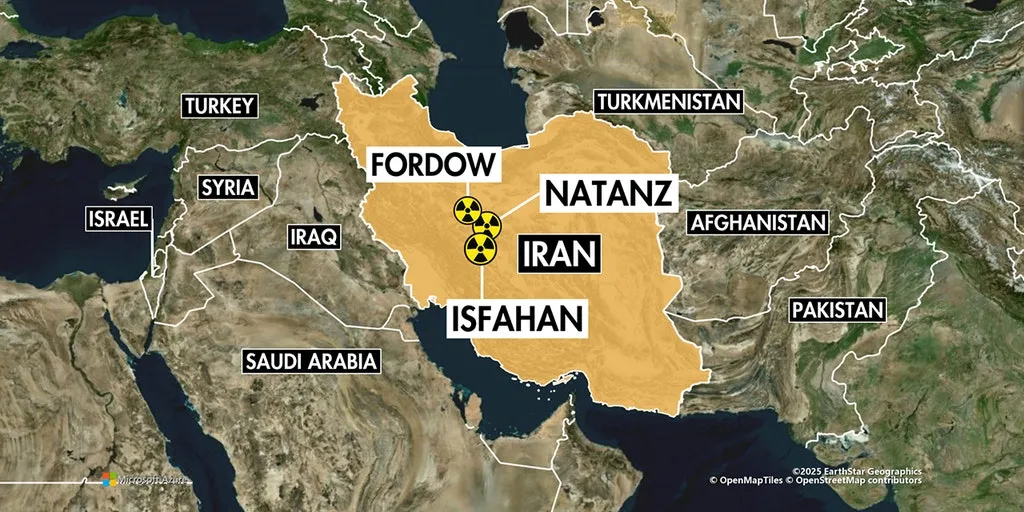U.S. Secretary of Defense Pete Hegseth and Joint Chiefs of Staff Chairman Dan 'Razin' Caine hold a press briefing at the Pentagon after the U.S. completed an attack on three key Iranian nuclear sites.
President Donald Trump declared last week that Iran's underground nuclear facilities bombed by the U.S. were "obliterated," while adding the U.S. and Israeli strikes delivered "monumental damage to all nuclear sites in Iran."
U.S. Defense Secretary Pete Hegseth echoed that message in a briefing, saying the "CIA can confirm that a body of credible intelligence indicates Iran's nuclear program has been severely damaged by recent targeted strikes."
Israeli intelligence sources told Fox News Digital that strikes on Natanz, Fordow and Esfahan caused severe and possibly irreversible damage to Iran's known enrichment infrastructure. "We hit the heart of their capabilities," one official said.
But despite the overwhelming success of the mission, questions remain about what survived - and what might come next. Analysts warn that while Iran's declared facilities have been largely destroyed, covert elements of the program may still exist, and enriched uranium stockpiles could resurface.
International Atomic Energy Agency (IAEA) Director Rafael Grossi said in an interview with CBS on Saturday that although "it's clear that what happened in particular in Fordow, Natanz, [and] Isfahan -- where Iran used to have, and still has to some degree, capabilities in terms of treatment, conversion, and enrichment of uranium -- has been destroyed to an important degree," the threat remains.
Nuclear experts say that while Iran's nuclear progress has been dealt a historic blow, the regime may still retain the technical know-how and residual capabilities to reconstitute its program over time - especially if it chooses to go dark.
A detailed assessment released Tuesday by the Institute for Science and International Security (ISIS) found that Israel's Operation Rising Lion, followed by U.S. bunker-busting strikes, "effectively destroyed Iran's centrifuge enrichment program." But authors David Albright and Spencer Faragasso cautioned that "residuals such as stocks of 60%, 20%, and 3-5% enriched uranium and centrifuges manufactured but not yet installed... pose a threat as they can be used in the future to produce weapon-grade uranium".
Jonathan Ruhe, director of foreign policy at the Jewish Institute for National Security of America (JINSA), echoed that concern in an interview with Fox News Digital.
"The threat now is certainly much reduced," Ruhe said. "But the threat from here on out is going to be much more difficult to detect because Iran could try to rebuild covertly. They don't need much space or time to enrich 60% to 90%. And the IAEA has said for years that Iran likely retains some secret capability."
Ruhe added that while Israeli intelligence was likely aware of attempts to move uranium before the strikes, "any planning assumption going forward must consider Iran's residual capacity - even if it's diminished."
John Spencer, chair of urban warfare studies at the Modern War Institute, said critics who argue the program wasn't completely destroyed are missing the bigger picture.
"Can everything be rebuilt eventually? Sure. But there's no question the program was rolled back - years, if not more," Spencer told Fox News Digital. "People fixate on how many pounds of uranium are missing. But building a bomb requires much more than material. You need the conversion, the metallurgy, the delivery system - all of which were hit."
Dr. Or Rabinowitz, a nuclear proliferation scholar at Hebrew University and visiting associate professor at Stanford, noted that many unknowns remain.
"There's no verified answer yet to what happened to the 60% enriched uranium - or to the other feedstocks at 20% or 3.5%," Rabinowitz said. "If Iran has access to advanced centrifuges, they could in theory enrich back to weapons-grade - but we don't know how many centrifuges survived or in what condition they are."
She also explained that even if Iran retains the material, converting uranium gas into metal for a bomb requires a specialized facility. "From what we know, that conversion facility in Isfahan was bombed. Without it, Iran faces a significant bottleneck," she said. But she warned that nuclear weapons technology is not insurmountable: "This is 1940s science. If North Korea could do it, Iran could too - eventually."
According to the ISIS report, "extensive damage" was confirmed at nearly all major Iranian nuclear and missile facilities, including the destruction of uranium metal conversion plants, fuel fabrication centers, and the IR-40 Arak heavy water reactor. The report noted that the Israeli and U.S. strikes "rendered the Fordow site inoperable," citing high-resolution satellite imagery of deep bunker penetrations.
Rabinowitz also emphasized that the intelligence picture is still developing in real time. "The Israelis and the Americans are now hard at work to generate the most accurate intelligence picture they can," she said. "Without having my own sources in the Mossad, I can guarantee the Israelis are monitoring internal Iranian communications, trying to figure out what the Iranians have figured out. As they learn more, so will Israel and the U.S."
As debate continues over whether the strikes were enough to permanently disable Iran's nuclear ambitions, analysts agree on one point: Iran's assumption that it could push forward without consequence is gone.
During a press conference on Friday. Trump was asked if he would bomb Iran's nuclear program again if it was restarted. He told reporters, "Sure without question."
